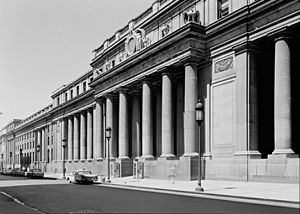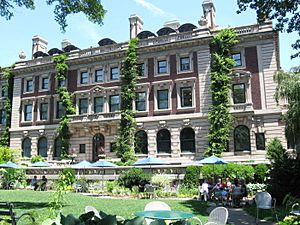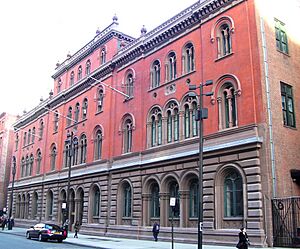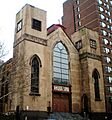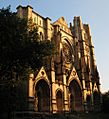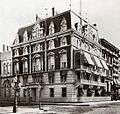New York City Landmarks Preservation Commission facts for kids
The New York City Landmarks Preservation Commission (LPC) is a special group in New York City. Its job is to protect important buildings and places. It makes sure these places keep their special look and history. The LPC is the biggest group of its kind in the United States.
By 2020, the LPC had protected over 37,000 properties. These include single buildings, special interiors, scenic spots, and whole neighborhoods. These protected areas are called "historic districts."
The Mayor of New York City, Robert F. Wagner Jr., started the LPC in 1962. The group became much stronger in 1965. This happened after the famous Pennsylvania Station was torn down. Many people were upset about this. The LPC has helped save many famous places, like Grand Central Terminal. By 1990, people said the LPC helped New York City keep its unique identity. It also made many neighborhoods more popular.
The LPC is run by eleven people called commissioners. A building must be at least 30 years old before the LPC can make it a landmark.
Contents
What the LPC Does
The main goal of the New York City landmarks law is to save beautiful and historic buildings. It also protects other important structures and objects. These things make New York City special. The LPC decides which properties should be protected. Then, it sets rules to keep their beauty and history safe.
The LPC protects not just famous buildings. It also saves the historical feeling of entire neighborhoods. These neighborhoods are called historic districts. The LPC looks after many different types of landmarks. For example, it protects Fonthill Castle in the North Bronx. This castle was built in 1852. It also protects the 1670s Conference House in Staten Island. Important people like Benjamin Franklin met there during the Revolutionary War.
The LPC helps keep the city's landmark properties safe. It does this by controlling changes to their important parts. The LPC's role has changed over time. This is especially true as the real estate market in New York City changes.
How Landmarks Are Chosen
Anyone can suggest a potential landmark to the LPC. This includes citizens, property owners, or even the LPC staff. First, the LPC checks out the suggested properties. They visit the sites to see which ones need more research.
Next, there are public hearings. People can share if they support or oppose a landmark idea. Remember, a building must be at least 30 years old to become a landmark. Six commissioners must vote "yes" for a property to be approved.
After approval, the idea goes to the New York City Council. The City Council gets reports from other city groups. Then, they decide to approve, change, or reject the landmark idea. Before 1990, a different group, the New York City Board of Estimate, had this power. Once the City Council approves, a landmark status can still be challenged. This can happen if someone files an appeal within 90 days.
Who Works at the LPC
The Landmarks Preservation Commission has 11 commissioners. They are not paid, except for the chairman. They work part-time for three years. By law, at least six of them must be experts. These include three architects, a historian, a city planner or landscape architect, and a realtor. Also, at least one commissioner must live in each of New York City's five boroughs.
The commission also has 80 full-time paid workers. These include lawyers, architects, historians, and researchers. Students and volunteers also help the commission. The staff is divided into six main groups.
- The research group studies buildings that might become landmarks.
- The preservation group checks and approves changes to existing landmarks.
- The enforcement group looks into reports of people breaking landmark rules.
- The archaeology group has four archaeologists. They check how new building projects might affect old sites. They also watch for any old discoveries.
- The environmental review group gathers information for other government groups. These groups need to check how their projects affect the environment.
- The Historic Preservation Grant Program gives money to owners of landmark properties.
Types of Landmarks
As of 2020, New York City has over 37,000 landmark properties. Most of these are in 150 historic districts across all five boroughs. There are also 1,439 individual landmarks, 120 interior landmarks, and 11 scenic landmarks. Some of these are also special national sites.
Here are the different types of landmarks:
- Individual landmark: This protects the outside of a building or object. The inside is not included unless it's named separately. An individual landmark must be at least 30 years old. It must also have a "special character" or be important to the city's history or culture.
- Interior landmark: This protects the inside of a building. It must meet the same rules as an individual landmark. It also needs to be a place that is usually open to the public.
- Scenic landmark: These are places owned by the city, like parks. They must meet the individual landmark rules. They are usually "parks or other landscape features."
- Historic districts: These are areas with many buildings that are important. They have "architectural and historical significance." Historic districts must also be connected geographically. They need to have a "coherent streetscape" and a "sense of place."
History of the LPC
Early Preservation Efforts
People in New York City have cared about saving old buildings for a long time. As early as 1831, a newspaper called the New York Evening Post spoke out. It was against tearing down an old house on Pearl Street. Before the LPC was created, people saved buildings by speaking up. Individuals or groups would fight to protect them. Many homes were saved this way. These include the Andrew Carnegie Mansion and the Percy R. Pyne House. Later, these became official landmarks. Other places like the Van Cortlandt House became museums.
However, early efforts often focused on saving old Colonial-style houses. They didn't pay much attention to other types of buildings. Support for preservation grew after World War II. Before that, many old buildings were torn down. This happened if they were not popular or if new development was planned. For example, the City Hall Post Office and Courthouse was demolished.
The tearing down of Pennsylvania Station between 1963 and 1966 was a big moment. Many people were very upset. This event helped start the modern preservation movement in the United States. It was especially important for New York City.
How the LPC Was Created
Mayor Robert F. Wagner Jr. started a committee in 1961 to save historic places. Then, on April 21, 1962, he officially formed the Landmarks Preservation Commission. It had twelve members who were not paid. Soon after, the LPC began naming buildings as landmarks.
At first, the LPC did not have much power. It could not stop Pennsylvania Station from being torn down. Because of this, an LPC member named Geoffrey Platt wrote a new Landmarks Law in 1964. This law would give the LPC much more power. The Mayor sent this new law to the New York City Council. The City Council was worried that New York City was losing its old buildings too quickly.
The new law passed the City Council on April 7, 1965. Mayor Wagner signed it into law on April 20. The first commissioners under this new law started in June 1965. Geoffrey Platt was the first chairman. The LPC held its first public meeting in September 1965. The first 20 landmarks were named the next month. The Wyckoff House in Brooklyn was the very first official landmark. Other early landmarks included the Astor Library and the Bowling Green U.S. Custom House. The first historic district, the Brooklyn Heights Historic District, was named in November 1965.
In its first year, the LPC named 37 landmarks and the Brooklyn Heights Historic District. Early landmarks were often government buildings or institutions. They were chosen because their preservation was not likely to cause arguments. However, some important buildings were still torn down in the first few years. These included the Singer Building.
Important Decisions
One of the most famous cases the LPC was involved in was saving Grand Central Terminal. Jacqueline Kennedy Onassis helped with this effort. In 1978, the highest court in the U.S., the United States Supreme Court, supported the landmarks law. This stopped the Penn Central Railroad from changing Grand Central Terminal. They wanted to build a large office tower above it. This victory was very important. It showed how much the LPC had grown since it couldn't save Pennsylvania Station.
Not all decisions are easy. The LPC has faced challenges with places like St. Bartholomew's Episcopal Church and some Broadway theatres. In 2010, the LPC decided not to give landmark status to a building on Park Place. This meant a new building, Cordoba House, could be built there.
The LPC also recognizes cultural landmarks. For example, Greenwich Village's Stonewall Inn is important not just for its architecture. It's recognized for its historical role in a designated historic district.
South Street Seaport and "New Market Building"
The South Street Seaport has been a historic district since 1977. After the Fulton Fish Market moved in 2005, people wanted to keep the area's history alive. They started a market called "New Amsterdam Market." They hoped to turn the old "New Market Building" into a permanent food market. This building was built in 1939 and has a special Art Deco design.
However, a real estate company called the Howard Hughes Corporation has a lease for much of the Seaport. They want to rebuild the area. This made locals worried that the New Market Building would be changed or destroyed. The company offered a smaller food market. But the market organizers were not happy. They felt it wasn't big enough and didn't guarantee the historic building's protection.
A group called "Save Our Seaport Coalition" formed. They wanted the New Market Building to become part of the historic district. They argued that the building was important because it housed the fish market for 66 years. They also said it was a good example of "WPA Moderne municipal architecture." This is a rare building style. However, in 2013, the LPC decided not to hold a hearing to make it a landmark. Many community groups still support protecting this building.
Little Syria and Washington Street
After the September 11 attacks in 2001, people worried about old buildings in Downtown Manhattan. They feared new development would erase the history of "Little Syria." This area was home to immigrants from today's Lebanon, Syria, and Palestine in the late 1800s and early 1900s. Other groups like Greeks and Irish also lived there. Over the years, many old buildings were torn down for new projects. Only a few low-rise historic buildings remain.
In 2003, a historian named Joseph Svehlak suggested making three buildings on Washington Street landmarks. These were the Downtown Community House, 109 Washington Street (an old apartment building), and the St. George's Syrian Catholic Church. After years of effort, the church became a landmark in 2009. However, the LPC did not hold hearings for the other two buildings.
Community groups still fight to protect the Downtown Community House. They say its history shows the many different cultures in the neighborhood. They also believe its architecture connects immigrants to the country's beginnings. They hope that saving all three buildings together would tell a complete story of this important neighborhood.
Former Landmarks
It is very rare for a landmark status to be removed. Sometimes, the New York City Council or the New York City Board of Estimate (before 1990) voted to remove it. Other times, buildings were torn down due to neglect or new construction. Then, the LPC removed their landmark status.
Images for kids
See also
 In Spanish: Comisión para la Preservación de Monumentos Históricos de Nueva York para niños
In Spanish: Comisión para la Preservación de Monumentos Históricos de Nueva York para niños


